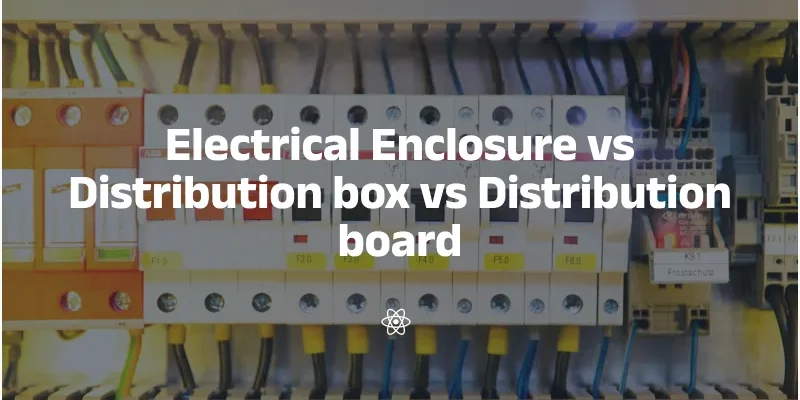ຝາປິດໄຟຟ້າ, ກ່ອງແຈກຈ່າຍ, ແລະກະດານແຈກຢາຍແມ່ນອົງປະກອບທີ່ສໍາຄັນໃນລະບົບໄຟຟ້າ, ແຕ່ລະປະຕິບັດຫນ້າທີ່ແລະການນໍາໃຊ້ທີ່ແຕກຕ່າງກັນ. ການເຂົ້າໃຈຄວາມແຕກຕ່າງຂອງພວກເຂົາແມ່ນສໍາຄັນສໍາລັບການເລືອກອຸປະກອນທີ່ເຫມາະສົມສໍາລັບຄວາມຕ້ອງການສະເພາະ.
ຕູ້ໄຟຟ້າ
ຕູ້ໄຟຟ້າເປັນຄໍາສັບທົ່ວໄປທີ່ຫມາຍເຖິງໂຄງສ້າງໃດກໍ່ຕາມທີ່ຖືກອອກແບບມາເພື່ອປົກປ້ອງອຸປະກອນໄຟຟ້າຈາກປັດໃຈສິ່ງແວດລ້ອມເຊັ່ນ: ຂີ້ຝຸ່ນ, ຄວາມຊຸ່ມຊື່ນ, ແລະຄວາມເສຍຫາຍທາງດ້ານຮ່າງກາຍ. ຝາປິດເຫຼົ່ານີ້ສາມາດແຕກຕ່າງກັນຢ່າງກວ້າງຂວາງໃນຂະຫນາດແລະຄວາມຊັບຊ້ອນແລະຖືກນໍາໃຊ້ໃນຄໍາຮ້ອງສະຫມັກຕ່າງໆ, ລວມທັງທີ່ຢູ່ອາໄສ, ການຄ້າ, ແລະອຸດສາຫະກໍາ.
ຄຸນນະສົມບັດທີ່ສໍາຄັນ:
- ການປົກປ້ອງ: ປ້ອງກັນອົງປະກອບໄຟຟ້າຈາກອັນຕະລາຍຕໍ່ສິ່ງແວດລ້ອມ.
- ວັດສະດຸ: ປົກກະຕິແລ້ວເຮັດຈາກໂລຫະຫຼືພາດສະຕິກ.
- ແອັບພລິເຄຊັນ: ໃຊ້ໃນການຕັ້ງຄ່າຕ່າງໆ, ລວມທັງເຮືອນ, ໂຮງງານ, ແລະການຕິດຕັ້ງນອກ.
ກ່ອງແຈກຢາຍ
ກ່ອງແຈກຈ່າຍ (DB) ແມ່ນປະເພດຂອງຕູ້ໄຟຟ້າທີ່ຖືກອອກແບບໂດຍສະເພາະສໍາລັບການແຈກຢາຍພະລັງງານໄຟຟ້າ. ມັນເຮັດຫນ້າທີ່ເປັນຈຸດສູນກາງທີ່ພະລັງງານໄດ້ຮັບຈາກການສະຫນອງຕົ້ນຕໍແລະແຈກຢາຍໃຫ້ວົງຈອນຕ່າງໆພາຍໃນອາຄານ.
ລັກສະນະ:
- ຂະໜາດ: ໂດຍປົກກະຕິມີຂະຫນາດນ້ອຍກວ່າກະດານແຈກຢາຍ; ສາມາດຕິດຝາໄດ້.
- ການທໍາງານ: ເຄື່ອງຕັດວົງຈອນ, ຟິວ, ແລະອຸປະກອນປ້ອງກັນອື່ນໆໃນບ້ານເພື່ອຄຸ້ມຄອງການສະຫນອງໄຟຟ້າຢ່າງປອດໄພ.
- ການນຳໃຊ້: ພົບເຫັນທົ່ວໄປໃນບ່ອນຢູ່ອາໃສ, ໂຮງຮຽນ, ແລະອາຄານພານິດຂະໜາດນ້ອຍສຳລັບເຮັດໃຫ້ມີແສງ ແລະ ການກະຈາຍພະລັງງານ.
ຄໍາຮ້ອງສະຫມັກຂອງກ່ອງແຈກຢາຍ:
- ໃຊ້ສໍາລັບການເຊື່ອມຕໍ່ສາຍໄຟຟ້າແລະສາຍໄຟ.
- ສະຫນອງການປ້ອງກັນການໂຫຼດເກີນແລະການປ້ອງກັນວົງຈອນສັ້ນ.
- ອໍານວຍຄວາມສະດວກໃນການເຂົ້າເຖິງໄດ້ງ່າຍສໍາລັບການບໍາລຸງຮັກສາ.
ກະດານແຈກຢາຍ
ກະດານແຈກຢາຍ, ເຊິ່ງເອີ້ນກັນວ່າກະດານກະດານຫຼືກະດານເບກເກີ, ແມ່ນປະເພດທີ່ກ້າວຫນ້າຂອງກະດານໄຟຟ້າທີ່ແຈກຢາຍໄຟຟ້າໄປສູ່ຫຼາຍວົງຈອນ. ມັນໄດ້ຖືກອອກແບບສໍາລັບການຕິດຕັ້ງຂະຫນາດໃຫຍ່ທີ່ຕ້ອງການການຄຸ້ມຄອງພະລັງງານຢ່າງຫຼວງຫຼາຍ.
ລັກສະນະ:
- ຂະໜາດ: ໂດຍທົ່ວໄປມີຂະຫນາດໃຫຍ່ກວ່າກ່ອງແຈກຢາຍ; ສາມາດຕິດພື້ນໄດ້.
- ຄວາມຊັບຊ້ອນ: ຮອງຮັບຫຼາຍວົງຈອນທີ່ມີຄວາມສາມາດໃນການໂຫຼດທີ່ສູງຂຶ້ນ; ປະກອບມີຄຸນສົມບັດເຊັ່ນອຸປະກອນປະຈຸບັນທີ່ເຫຼືອ (RCDs) ເພື່ອຄວາມປອດໄພທີ່ເພີ່ມຂຶ້ນ.
- ການນຳໃຊ້: ຖືກນໍາໃຊ້ທົ່ວໄປໃນສະພາບແວດລ້ອມການຄ້າແລະອຸດສາຫະກໍາທີ່ການແຈກຢາຍພະລັງງານຢ່າງກວ້າງຂວາງແມ່ນມີຄວາມຈໍາເປັນ.
ຫນ້າທີ່ຂອງກະດານແຈກຢາຍ:
- Centralizes ການຄວບຄຸມໃນໄລຍະຫຼາຍວົງຈອນ.
- ສະຫນອງການປ້ອງກັນການ overloads ແລະຄວາມຜິດ.
- ອໍານວຍຄວາມສະດວກໃນການຄຸ້ມຄອງລະບົບແຮງດັນທີ່ສູງຂຶ້ນ.
ຕາຕະລາງປຽບທຽບ
| ຄຸນສົມບັດ | ຕູ້ໄຟຟ້າ | ກ່ອງແຈກຢາຍ | ກະດານແຈກຢາຍ |
|---|---|---|---|
| ຂະໜາດ | ແຕກຕ່າງກັນຢ່າງກວ້າງຂວາງ | ນ້ອຍກວ່າ (ຕິດຝາ) | ໃຫຍ່ກວ່າ (ຕິດຢູ່ພື້ນ) |
| ການທໍາງານ | ການປົກປ້ອງທົ່ວໄປ | ການກະຈາຍພະລັງງານ | ການຄວບຄຸມວົງຈອນສູນກາງ |
| ການນໍາໃຊ້ທົ່ວໄປ | ການຕັ້ງຄ່າທັງໝົດ | ທີ່ຢູ່ອາໄສ ແລະການຄ້າຂະໜາດນ້ອຍ | ການຄ້າ ແລະອຸດສາຫະກຳ |
| ອົງປະກອບ | ແຕກຕ່າງກັນ | ເຄື່ອງຕັດວົງຈອນ & ຟິວ | ເຄື່ອງຕັດວົງຈອນ & RCDs |
| ຄວາມອາດສາມາດໂຫຼດ | ຂຶ້ນກັບການອອກແບບ | ແຮງດັນຕໍ່າ | ແຮງດັນສູງ |
ສະຫຼຸບ
ສະຫລຸບລວມແລ້ວ, ໃນຂະນະທີ່ທັງສາມອົງປະກອບແມ່ນສໍາຄັນໃນການຄຸ້ມຄອງລະບົບໄຟຟ້າ, ພວກມັນແຕກຕ່າງກັນຢ່າງຫຼວງຫຼາຍໃນຂະຫນາດ, ຫນ້າທີ່ແລະຄໍາຮ້ອງສະຫມັກ. enclosures ໄຟຟ້າສະຫນອງການປົກປ້ອງທົ່ວໄປ; ກ່ອງແຈກຈ່າຍອຳນວຍຄວາມສະດວກໃນການກະຈາຍພະລັງງານທີ່ປອດໄພໃນການຕັ້ງຄ່າຂະໜາດນ້ອຍ; ແລະກະດານແຈກຢາຍຄຸ້ມຄອງລະບົບໄຟຟ້າທີ່ຊັບຊ້ອນໃນການຕິດຕັ້ງຂະຫນາດໃຫຍ່. ຄວາມເຂົ້າໃຈກ່ຽວກັບຄວາມແຕກຕ່າງເຫຼົ່ານີ້ຊ່ວຍຮັບປະກັນການເລືອກທີ່ເຫມາະສົມກັບຄວາມຕ້ອງການໄຟຟ້າສະເພາະ.


